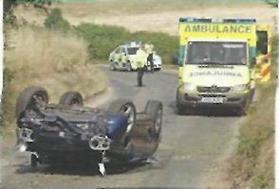Match the beginnings and endings of the sentences
| 1.
| Check that
|
| a.
| I count up to between breaths?
| | 2.
| Make sure you
|
| b.
| I give her?
| | 3.
| What do
|
| с.
| have to apply the pads?
| | 4.
| Don't let
|
| d.
| the patient is breathing.
| | 5.
| Should I
|
| e.
| the patient try to stand up.
| | 6.
| Shall I bandage
|
| f.
| put the burnt area under running water?
| | 7.
| Don't I
|
| g.
| the patient's pulse again.
| | 8.
| What dosage shall
|
| h.
| tie the bandage too tight!
| | 9.
| Take
|
| i.
| the wound now?
| | 10.
| Where do I
|
| j.
| use a sterile needle.
|
Reading
Read and discuss the texts in pairs
A defibrillator is used to make the heart start beating correctly after it has stopped or become irregular. It works by sending an electric shock through paddles or electrodes placed on the patient's chest.
Taxi drivers in Bangkok are now being trained to help women give birth. An estimated 300—400 women in the city give birth in taxis or tuk-tuks on the way to hospital each year.
Worldwide, somebody is killed in a car accident every 30 seconds. (World Health Organization statistics)

Signs and symptoms
Shock
Paramedics often have to deal with shock, a condition that is often caused by major trauma such as a traffic accident. Shock occurs when the heart is unable to supply enough blood to the organs. This results in a slowing-down of the vital functions, and can cause death. Shock is difficult to diagnose in its early stages, which makes it hard to treat.
Read about the signs and symptoms of shock, and complete them with words below.
| dangerously
| blood pressure
| | abdominal
| cardiovascular
| | respiratory
| intestines
| | abnormally
| coma
| | gastrointestinal
| central nervous system
| The ____________is affected.
This can cause changes in personality, and restlessness. In advanced stages,
confusion and ultimately can result.
 
Тема 9.2. Fractures / Переломы
LevelA
We learn the new words / Мыучимновыеслова:
fracture /frækʧǝ/ n перелом (от лат fracture)
to move /mu:v/ v двигать
swelling /sweliŋ/ n опухоль
to break /breik/ v (broke, broken) ломать; n перелом
to appear /ǝ'piǝ/ v появляться
splint /splint/ n шина
bone /boun/ n кость
to bind /baind/ v перевязывать
closed /klouzd/ а закрытый
X-rays /eks'reiz/ n рентген
open а открытый
tocomplainof /kǝm'plein/ v жаловаться (наболь)
plaster cast /plɑ:stǝ 'kɑ:st/ гипсоваяповязка
FRACTURES
The word "fracture" means a break in a bone. There are two kinds of fractures: closed and open.
In a closed fracture there is no wound on the skin.
In an open fracture there is a wound. Open fractures are more serious than closed ones. If a person breaks his arm or leg, he complains of pain in the place of the break, the pain becomes more severe if' he presses the place or tries to move.
Swelling appears quickly. Do not let the person move. Use a splint for the broken limb. Bind the splint to the limb but not at the place of the fracture.
Doctors use X-rays to see the break and put plaster casts on the broken limbs.
|